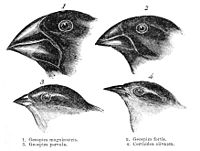
Photo from wikipedia
Species diversity can be inferred using multiple data types, however, results based on genetic data can be at odds with patterns of phenotypic variation. Tiger beetles of the Cicindelidia politula… Click to show full abstract
Species diversity can be inferred using multiple data types, however, results based on genetic data can be at odds with patterns of phenotypic variation. Tiger beetles of the Cicindelidia politula (LeConte, 1875) species complex have been taxonomically problematic due to extreme phenotypic variation within and between populations. To better understand the biology and taxonomy of this group, we used mtDNA genealogies and multilocus nuclear analyses of 34,921 SNPs to elucidate its evolutionary history and evaluate the validity of phenotypically circumscribed species and subspecies. Genetic analyses recovered two divergent species that are also ecologically distinct, based on adult life history. These patterns are incongruous with the phenotypic variation that informed prior taxonomy, and most subspecies were not supported as distinct evolutionary lineages. One of the nominal subspecies was found to be a cryptic species; consequently, we elevate C. p. laetipennis (Horn, 1913) to a full species. Although nuclear and mtDNA datasets recovered broadly similar evolutionary units, mito-nuclear discordance was more common than expected, being observed between nearly all geographically overlapping taxonomic pairs. Additionally, a pattern of ‘mitochondrial displacement’ was observed, where mitochondria from one species unidirectionally displace others. Overall, we found that geographically associated life history factors better predict genomic divergence than phenotype and mitochondrial genealogies, and consequently taxon identifications based on mtDNA (e.g., DNA barcodes) may be misleading.
Journal Title: Genes
Year Published: 2020
Link to full text (if available)
Share on Social Media: Sign Up to like & get
recommendations!